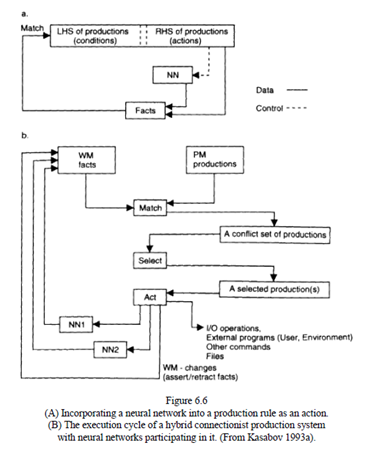Incorporating Neural Networks Into Production Rules
Introduction:-The idea of two-level knowledge processing, discussed in the previous section, is implemented here by using a standard production system for higher-level processing and neural networks for low-level processing. The main idea of incorporating neural networks into a production rule is to activate the networks as actions in the right-hand side of the production. Facts from the working memory are passed as input vectors to the neural networks. The output vectors, produced by the neural networks, are considered new facts. They may be either asserted in the working memory and possibly affect other productions during a next match-select-act cycle of the production system, or they can be used in the current production by activating other actions. Thefollowing example illustrates how neural networks are incorporated into productions.
Example

The problem is to classify a new object into defined categories, and to make a decision how to react to it to "greet" or "destroy" it.
We assume that there are plenty of examples available about different objects which can be used to train a neural network to do the classification task. The final decision will be taken as a conclusion in a production rule (higher-level processing). The following three rules realize the whole task.
A neural network is called for the classification task:
(Rule 1 "classify “IF (the goal is to classify a new object O) AND
(data about the object O is available in the working memory),
THEN (activate a trained neural network NN to classify the object O) (assert the classification result into the working memory))
(Rule 2 "destroy “IF (the object O is classified as "an enemy"),
THEN (send a message and "destroy" the object O))
(Rule 3 "greet “IF (the object O is classified as a "friend"), THEN (send a message and "greet" the object O)
The first rule in the example above activates an already trained network for rapid recognition of a new object O supplying the data about the object from the working memory to a trained neural network as an input vector. It saves the result from the connectionist classification (the network outputs) back into the working memory. The second and third rules are to make the decision. In this way, productions in a production system may deal with incomplete data and perform approximate reasoning, in this case a best-fit classification. Neural networks can accumulate knowledge during operation. A neural network, for example, can be trained during execution of the production system.